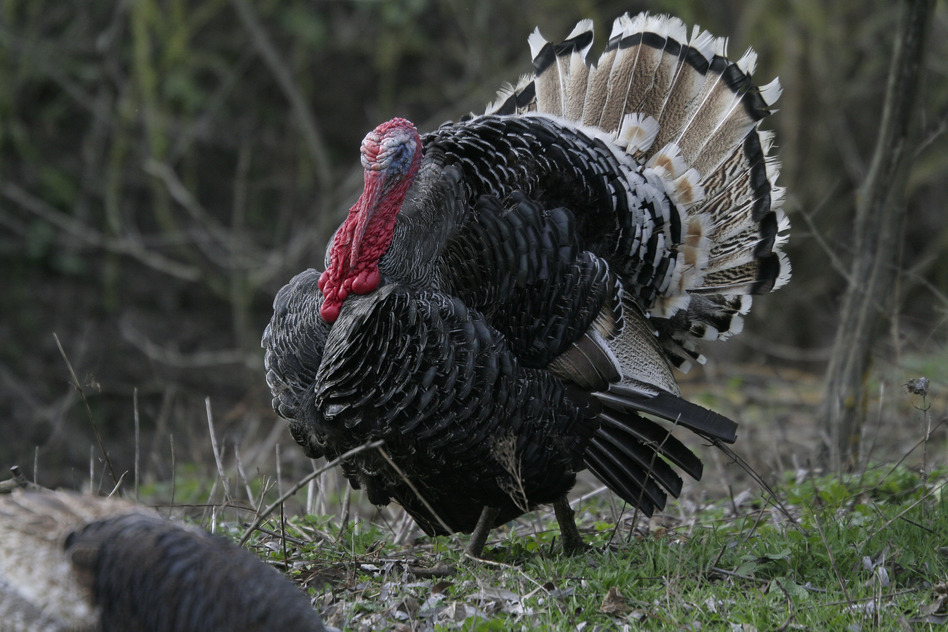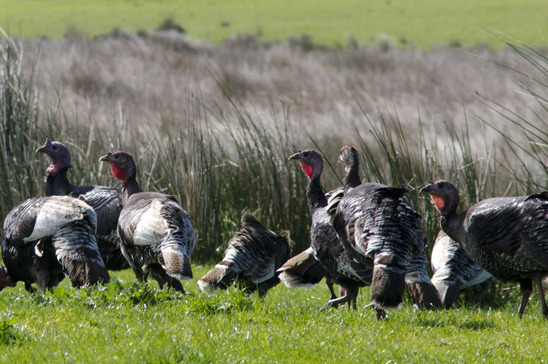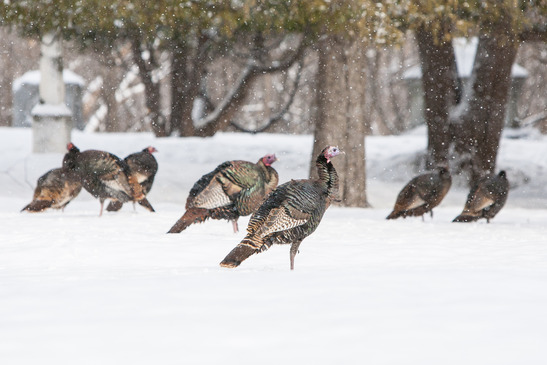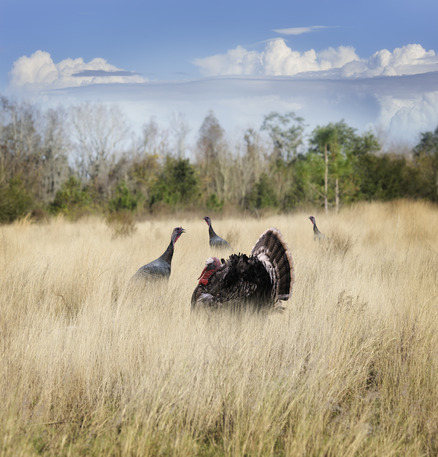A Way of Life in the USA
Hunting is a way of life in the United States, and we are here to help you be as successful on the hunt as possible.
20 Turkey Hunting Tips to help you Bag a Gobbler
 Turkey hunting is one of the most popular forms of hunting in the United States. Whether you’re looking to have a great time with family or friends, want to catch your own Thanksgiving dinner or just enjoy the quiet excitement of the hunt, turkey hunting can provide many memorable moments no matter if you get one or not. To ensure that you have a successful and safe turkey hunting trip, there are a few tips and tricks that you should keep in mind.
Turkey hunting is one of the most popular forms of hunting in the United States. Whether you’re looking to have a great time with family or friends, want to catch your own Thanksgiving dinner or just enjoy the quiet excitement of the hunt, turkey hunting can provide many memorable moments no matter if you get one or not. To ensure that you have a successful and safe turkey hunting trip, there are a few tips and tricks that you should keep in mind.
1 – Remember that Turkeys are Very Cautious
A common mistake of a first time turkey hunter is believing that turkeys won’t pay much mind to noises or movement. This is entirely false. Turkeys, particularly hens, tend to be quite paranoid if they believe a possible predator is around. Even the smallest sound such as a twig breaking hundreds of feet away or a rustle in the bushes can have them running off. In addition, turkeys have fantastic eye sight, meaning that staying still, moving slowly when movement is necessary and proper camouflage and cover are essential for getting close to turkeys without them spotting you.
2 – Learn the Patterns of Turkeys
Turkeys tend to be on the move a lot over the course of a day. They have their regular roosting areas, though these can change under various circumstances such as predatory threats, and they move on to known feeding areas, sources of water and some resting spots before returning to the roost. If you know of a flock of turkeys that frequents an area, track them and learn their patterns to know exactly when it is the best time to go out and where they’ll likely be.
3 – Seeking Possible Turkey Habitats
If you can’t manage to catch a glimpse of any turkeys to track, you’ll need to figure out what areas any local turkeys might be living, breeding or feeding in. Turkeys love condensed areas with tall and thick trees to roost in since these areas provide plenty of shelter and protection from predators. It’s considered very unethical to shoot turkeys out of the roost, and it’s even illegal in some states, but finding the roosting areas and calling them out is a great place to start.
A turkey’s diet is very vast since it is an omnivore, but they commonly travel to meadows, areas with thick brush and fields. Anywhere that has plenty of food such as bugs, nuts, berries, fruits, flowers, worms and grass is a good bet. If the area has a good water source nearby, that makes it an even better spot.
Breeding areas vary a lot, even in how far gobblers travel in mating season. Some male turkeys send out mating calls from the roost and don’t stray very far from home to breed. Other turkeys travel miles to mate. Generally, good mating areas are at least slightly open as this provides gobblers with plenty of room to strut and attract mates.
Turkeys will change roosting, feeding, breeding, drinking and resting locations a lot depending on weather, seasonal changes, intrusions and other factors. Luckily, it’s pretty easy to keep up with them through droppings, feathers and scratch marks.
 4 – Call Like a Flock
4 – Call Like a Flock
Properly utilizing calls is very important in turkey hunting. Many turkeys respond better to calls when they sound like an entire flock. Sounds of hens and rival gobblers call in toms and sounds of chicks and gobblers draw out hens. When you have drawn the turkeys out, decrease the amount of calls gradually until you’re using none. Continuing to use all of the calls at once may end up driving away the turkeys if they get close enough since the loud sounds at close range could spook them.
5 – Carry Multiple Calls
All turkeys react differently to various calls. While one turkey may respond to a box call, another turkey may completely ignore it. You could have great success with slate calls in one area and complete failure with them in another. Since you never know what calls may end up working and which ones are duds, it’s a good idea to keep several different types of calls on you and alternating between them when you find that your luck is running dry on one.
6 – Practice the Various Types of Call
Calling is an art form to some hunters, and it’s understandable since knowing what call to use, how to use it and when can make or break a hunt. While turkeys have over 30 different calls that they use for various purposes, hunters typically only use about 10 at most, and many hunters find plenty of success in merely using two calls, the plain cluck and the hen yelp. Other useful calls include the roost cluck, cackling, lost yelps and distress calls of baby turkeys. Most of these calls are easy to learn, but they also require practice in order to be as effective as possible. Luckily, there are many CDs, DVDs, online instructional videos and even classes that can help you with this.
7 – Gradually Increase Call Volume
When calling, start out at a very low volume. This is to prevent you from accidentally spooking away any turkeys that are close by. If there is no visible or audible response within 10 to 15 minutes, increase the volume. Stay at that pace until a turkey emerges or you’re at a reasonably loud volume. Don’t purposely try to be extremely loud as this may cause the call to sound unrealistic and may end up scaring away nearby turkeys.
8 – Properly Utilize Decoys
Decoys are a powerful tool in any turkey hunter’s arsenal, but there is some technique to using decoys properly. For instance, the number of decoys being used can have a massive effect. A single gobbler decoy may be enough to draw in a few hens or a rival tom, but it can be made much more effective with a few other decoys around to draw further interest.
Don’t just buy a bunch of decoys and spread them out over a few yards. Instead, create a scene that will be irresistible to the turkeys. Place one gobbler decoy in plain sight to spark some initial interest and place two or three hen decoys around it, spacing them out in varying distances but not putting any decoy further than 15 feet away from the gobbler decoy. This may trick a tom into believing that not only is there a rival gobbler nearby but also that he’s taken some of his potential mates.
Ensure that your decoys are no further than 20 feet away from your chosen hunting spot. Remember, once the turkeys are out you won’t be able to move very easily. If you draw turkeys to the decoy spot but are unable to get a decent shot from your area, it will likely all be for nothing.
9 – Know When Not to Use a Decoy
While decoys can be incredibly useful, there are some circumstances where using them can be pointless or even detrimental to your hunt. If your preferred hunting spot is in dense woodlands or anywhere with heavy cover, turkeys won’t be able to see the decoys very well. If you know that many people have been using decoys in the area lately, it’s probably best not to put them out. The heavy pressure on the turkeys will make them very wary of investigating them. Finally, you may not want to use decoys in heavily saturated hunting areas as it could create a safety concern. If you do plan on using decoys in these areas, ensure that your presence near the decoys is made aware to any nearby hunters. Always use blaze orange ribbons when placing and moving the decoys.
10 – Plan Your Hunting Clothes Accordingly
 Staying safe from accidental encounters with other hunters means ensuring that hunters can differentiate you from their targets. Typical colors on turkeys include red, white, black and blue, and some hunters may direct their firearms in the direction of those colors even without confirming that the color is on a turkey. To stay as safe as possible, remove any exterior items of clothing that include these colors.
Staying safe from accidental encounters with other hunters means ensuring that hunters can differentiate you from their targets. Typical colors on turkeys include red, white, black and blue, and some hunters may direct their firearms in the direction of those colors even without confirming that the color is on a turkey. To stay as safe as possible, remove any exterior items of clothing that include these colors.
You’ll also need to have full-body camouflage. Remember, turkeys have great eye sight, and the color of flesh and other out of place colors will likely warn them to move away from your area. Your shirt, jacket, pants, gloves, hat and boots should all be camo, and you should also have a full camo face mask or camo face paint to ensure that you blend in as much as possible.
Varying types of camouflage will also be beneficial at different times of year. At the start of spring, not much of the foliage has grown back. There are still a lot of dead leaves and bare bushes and trees in the area. Camo with darker green colors with brown and gray mixed through is most beneficial at this time of year. As spring goes on and the foliage returns, you can switch to lighter green colors with a touch of dark yellow and light brown.
11 – Choosing the Right Turkey Hunting Boots
It’s not uncommon for hunters to make the mistake of using regular hunting boots while hunting turkey. The problem is that, unlike hunting deer or most other types of game, turkey hunting requires you to cover quite a bit of land and traverse over many types of terrain. Hunting boots might do the trick, but you may also end up being very uncomfortable or wet. Do some research on the land to know exactly what type of obstacles you’ll be dealing with. Areas with a lot of water will call for high boots made out of waterproof material. Hunting boots with more of a hiking boot design will be better for rocky and hilly terrain.
12 – Have a Backup Hunting Spot
Many hunters decide to set up on public land. While this is perfectly fine, it also means that many good hunting spots are usually crowded with several hunters at a time. This could mean that your intended hunting spot might be taken or unusable when you arrive. Saturated hunting areas not only make getting a shot a nightmare for many hunters but it also means that many shots could be very risky depending on how close everyone is.
While some hunting spots may be taken, there are still usually acres and acres of untouched land that might be of some use to you. It’s best to find a backup spot before the season starts, but you may be able to plan out a decent spot at the last minute if you have a general idea of where the birds will be heading throughout the day.
13 – Knowing the Weather
Some turkey hunters prefer hunting in the rain for several reasons. First, there are usually many worms and bugs out for turkeys to eat during the rain. Second, the sound of rain helps mask many of the minor movements that you may make. Finally, wet grass and leaves make much less sound when stepped on or moved than when they’re dry. However, there is the threat of heavy rains, which usually prompts turkeys to retreat to sheltered areas until the rain lightens up.
There are also many benefits to hunting on sunny days. For instance, turkeys love soaking up the warmth of the sun, and they’ll seek out beautiful wide open areas in order to catch the sunlight. This makes the turkeys much easier to spot and it will make any shot opportunities much clearer. Additionally, choosing a spot where the sun will be on your back for most of your hunting time will create glare on anything trying to look at you, which will help prevent the turkeys from spotting you easily.
A long winter, frequent freezes and lasting cold weather may also affect the patterns of turkeys. Instead of going to their usual springtime feeding and resting areas, they may choose to stay in their winter patterns. This usually involves finding sunny places to rest in order to keep warm and feeding in places with high-calorie foods such as corn and bean fields.
Particularly hot weather prompts turkeys to find someplace shady and cool to rest. These areas are typically not far from a water source.
14 – Learn the Season Dates and Regulations for Your State
Each state has their own season opening and closing dates as well as their own specific regulations and rules for hunting turkey. It’s the responsibility of every hunter to ensure that they’re hunting legally, safely and ethically, and learning these rules is vital to achieving that. Luckily, guidebooks that include these rules are readily available online, in nearly any local sporting goods store or your local fish and game club. Study them thoroughly, get an updated book every year and always check the book if you’re unclear on anything, even when you’re out in the field.
 15 – Keep Up with Scouting
15 – Keep Up with Scouting
It’s already been established that turkeys commonly change their patterns and set locations such as roosts depending on many factors. Because of this, it is very important to do pre-season scouting and keep up with the scouting until the day that you’re ready to hunt. You don’t want to set up a hunting spot in a location where you assume the turkeys will be based on scouting information you received a couple of weeks ago.
In addition, ensure that you’re utilizing proper scouting practices. Try not to disturb the area as much as possible to avoid spooking away game. This includes refraining from using your turkey calls. Follow fresh tracks as much as possible. Old tracks are still indicative of turkeys in the area, but every day that passes is another opportunity for them to change patterns or for predators to grab them first. Look for dark and deep scratch marks and foot prints in soft soil and sand. The lighter and harder a track is, the older and more useless it is. Look for droppings that look dark and wet. Old droppings will look dry and light in color.
16 – Use a Turkey Vest
Turkey hunting requires a lot of small pieces of gear, equipment and supplies that would likely get lost in a hunting bag. Turkey vests allow you to keep every essential piece of equipment such as calls, strikers, flashlights, decoys, maps, shells and more all organized and quickly accessible. In addition, many turkey vests come with convenient features such as built-in cushioned seats, blood-proof game bags and blaze orange flags in the event of an emergency.
17 – Don’t Stalk
The aim of turkey hunting is to make them come out to you. Due to their keen senses of vision and hearing, it’s incredibly difficult to stalk a turkey to begin with. However, it can be very tempting to start stalking if you become impatient or want to somehow get the jump on your target. Stalking turkeys is incredibly dangerous, and over half of all hunting accidents in turkey hunting happen due to one hunter accidentally stalking the calls of another hunter. If you hear another turkey call, always assume that it’s another hunter.
18 – Tag Team Hunt
A great way to lure turkeys out of hiding and near you is to hunt in pairs. Turkeys are notorious for essentially teasing hunters. They’ll get just close enough to you to be spotted yet will studiously avoid getting close enough for a shot before leaving entirely. In order to avoid this, have a hunting partner call in the turkey towards them about 10 to 20 yards directly behind where you are. This will usually allow you to get close enough to the turkey to get a good shot. Just remember to ensure where your partner is at all times. Losing track of them as you’re prepping a shot could result in an accident.
19 – The Best Time of Day
Many hunters will tell you that it’s always best to go out turkey hunting before dawn ever breaks. Getting to your hunting area before 4:00 a.m. gives you the opportunity to get very close to the roosting spot of the turkeys. If your timing is right, you can call a gobbler out of his roost and towards you fairly easily at this time.
However, many hunters will likely have this same idea, possibly creating a problem in public hunting areas. In addition, turkeys will quickly catch onto this pattern and eventually ignore calls in the early morning hours.
When this happens, it’s much better to switch to mid and late morning, especially in the middle and end of the season. Not only does this allow you to sleep in and get plenty of rest for the hunt ahead, but it’s also an even better time to get gobblers. At this point in the season, breeding has already occurred, and the hens are starting to spend most of their time warming their eggs while the toms wander around with nothing to do. This will provide you with a great opportunity to lure some frustrated toms out of hiding.
20 – Use Blaze Orange on the Turkey
If you’re able to finally bag and tag a turkey, it’s a good idea to put some blaze orange ribbon on the turkey as soon as possible. Just like with placing and moving decoys, this ribbon will alert other hunters in the area that the turkey that they may have their sights on is not one that is safe to shoot, which will help prevent hunting accidents.
Conclusion
With all of these turkey hunting tips in mind, remember that the core concepts behind a successful hunt still stand. Be patient, persistent, stay safe and have fun. Simply seeing some turkeys and other wildlife or enjoying the great outdoors can be called a successful hunt. Never lose hope that you could end up with a trophy turkey on your wall. Many people go the entire season without seeing anything and end up bagging a nice jake or tom on the last day of hunting. Anything’s possible on a turkey hunt, and that’s what makes it so exciting.
